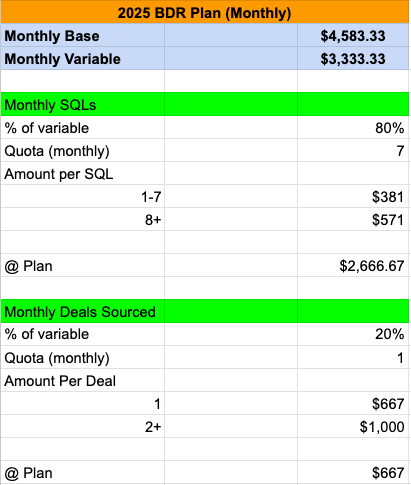
Outbound Comp Plan
How to design a BDR plan that drives results
Read Time = 3 minutes

There are three reasons why Sales and Biz Dev reps quit companies:
Lack of career progression
Below market comp plans
A boss they don’t like
Today we’re going to address the second item - comp plans.
Specifically, how to structure BDR comp plans using this template.
There’s something for everyone:
Reps: comparing your plan to market averages
Managers: designing a comp plan for your team
Executives: understand the economics of hiring BDRs
Let’s dive in.
How to Structure Comp
Most Biz Dev reps (BDR) comp plans follow a 60/40 or 70/30 base to variable split.
The larger base component for BDRs acknowledges several key factors:
Higher rejection rates: outbound involves significant rejection and a stable base salary helps maintain morale and reduce turnover
Early-career demographics: many BDRs are in entry-level positions and benefit from predictable income while developing their skills
Limited control: BDRs hand off opportunities and have minimal influence on the closing process

While base salaries are typically consistent across companies, variable is not.
Common variable components to outbound BDR plans:
New Lead Scheduled : calendar commitment
Meetings Completed: attended by prospect
Sales Qualified Leads (SQL): vetted for ICP fit
Pipeline Generated: dollar value attributed to SQLs
Revenue: closed won deals sourced by the BDR
My preference is to pay reps on meetings completed or SQLs. Naturally, execs often want to align BDR comp to actual revenue so they push for alignment to revenue. More on this in the example below.
What metrics are tied to BDR compensation?

Template for Building BDR Plans
Recently I helped a B2B SaaS company build their outbound GTM playbook.
A key part of this engagement was hiring reps and building their comp plan.
The company was planning for $85-95k in on target earnings (OTE).
Right in line with industry averages:

Source = mostly metrics
Let’s use my experience referenced above to build out an example comp plan.
You can use this BDR comp template and follow the breakdown below.
EXAMPLE
Quota: 7 SQLs per month and 1 closed deal sourced by the BDR
Commission Structure: $286 per SQL and $667 per closed won deal generated
Variable at Quota: $40,000
Base Salary: $55,000
OTE:$95,000
Notes: There are two different quotas and therefore two different commission rules for this sample BDR plan. First, reps are paid a flat $381 bonus for every qualified opportunity they generate - if they exceed quota they are paid an accelerated rate. Second, reps are expected to source 1 closed deal of revenue per month. If the rep exceeds their closed won deal volume quota, they are paid a 1.5x accelerator.

Link to the template here
I was tempted to include an FAQ section and then realized most of you probably don’t want to read a novel on how to create Biz Dev plans.
(bless you if you’ve made it this far)
That said, I’m happy to address any questions when it comes to:
specifics of creating a comp plan for your company
how to address ramp quota and commissions
inbound vs outbound compensation
start-up vs enterprise comp plans
benchmarks and best practices
…
You know where to find me when you get lost.
Until next Thursday,
TSG
P.S. I reply to all emails.
